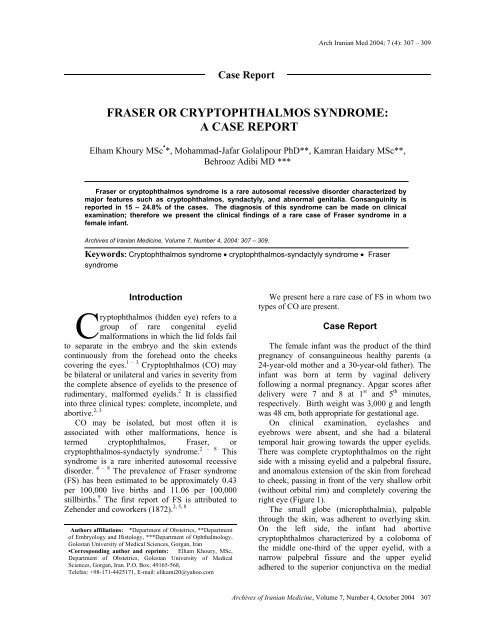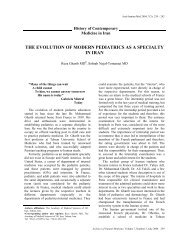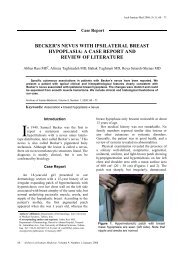FRASER OR CRYPTOPHTHALMOS SYNDROME: A CASE REPORT
FRASER OR CRYPTOPHTHALMOS SYNDROME: A CASE REPORT
FRASER OR CRYPTOPHTHALMOS SYNDROME: A CASE REPORT
Create successful ePaper yourself
Turn your PDF publications into a flip-book with our unique Google optimized e-Paper software.
Arch Iranian Med 2004; 7 (4): 307 – 309<br />
<strong>FRASER</strong> <strong>OR</strong> <strong>CRYPTOPHTHALMOS</strong> <strong>SYNDROME</strong>:<br />
A <strong>CASE</strong> REP<strong>OR</strong>T<br />
Elham Khoury MSc • *, Mohammad-Jafar Golalipour PhD**, Kamran Haidary MSc**,<br />
Behrooz Adibi MD ***<br />
Fraser or cryptophthalmos syndrome is a rare autosomal recessive disorder characterized by<br />
major features such as cryptophthalmos, syndactyly, and abnormal genitalia. Consanguinity is<br />
reported in 15 – 24.8% of the cases. The diagnosis of this syndrome can be made on clinical<br />
examination; therefore we present the clinical findings of a rare case of Fraser syndrome in a<br />
female infant.<br />
Archives of Iranian Medicine, Volume 7, Number 4, 2004: 307 – 309.<br />
Keywords: Cryptophthalmos syndrome • cryptophthalmos-syndactyly syndrome • Fraser<br />
syndrome<br />
Introduction<br />
ryptophthalmos (hidden eye) refers to a<br />
group of rare congenital eyelid<br />
malformations in which the lid folds fail<br />
to separate in the embryo and the skin extends<br />
continuously from the forehead onto the cheeks<br />
covering the eyes. 1 – 3 Cryptophthalmos (CO) may<br />
be bilateral or unilateral and varies in severity from<br />
the complete absence of eyelids to the presence of<br />
rudimentary, malformed eyelids. 2 C<br />
It is classified<br />
into three clinical types: complete, incomplete, and<br />
abortive.<br />
2, 3<br />
CO may be isolated, but most often it is<br />
associated with other malformations, hence is<br />
termed cryptophthalmos, Fraser, or<br />
cryptophthalmos-syndactyly syndrome. 2 – 8 This<br />
syndrome is a rare inherited autosomal recessive<br />
disorder. 4 – 8 The prevalence of Fraser syndrome<br />
(FS) has been estimated to be approximately 0.43<br />
per 100,000 live births and 11.06 per 100,000<br />
stillbirths. 9 The first report of FS is attributed to<br />
2, 5, 8<br />
Zehender and coworkers (1872).<br />
Authors affiliations: *Department of Obstetrics, **Department<br />
of Embryology and Histology, ***Department of Ophthalmology,<br />
Golestan University of Medical Sciences, Gorgan, Iran<br />
•Corresponding author and reprints: Elham Khoury, MSc,<br />
Department of Obstetrics, Golestan University of Medical<br />
Sciences, Gorgan, Iran. P.O. Box; 49165-568,<br />
Telefax: +98-171-4425171, E-mail: elikami20@yahoo.com<br />
Case Report<br />
We present here a rare case of FS in whom two<br />
types of CO are present.<br />
Case Report<br />
The female infant was the product of the third<br />
pregnancy of consanguineous healthy parents (a<br />
24-year-old mother and a 30-year-old father). The<br />
infant was born at term by vaginal delivery<br />
following a normal pregnancy. Apgar scores after<br />
delivery were 7 and 8 at 1 st and 5 th minutes,<br />
respectively. Birth weight was 3,000 g and length<br />
was 48 cm, both appropriate for gestational age.<br />
On clinical examination, eyelashes and<br />
eyebrows were absent, and she had a bilateral<br />
temporal hair growing towards the upper eyelids.<br />
There was complete cryptophthalmos on the right<br />
side with a missing eyelid and a palpebral fissure,<br />
and anomalous extension of the skin from forehead<br />
to cheek, passing in front of the very shallow orbit<br />
(without orbital rim) and completely covering the<br />
right eye (Figure 1).<br />
The small globe (microphthalmia), palpable<br />
through the skin, was adherent to overlying skin.<br />
On the left side, the infant had abortive<br />
cryptophthalmos characterized by a coloboma of<br />
the middle one-third of the upper eyelid, with a<br />
narrow palpebral fissure and the upper eyelid<br />
adhered to the superior conjunctiva on the medial<br />
Archives of Iranian Medicine, Volume 7, Number 4, October 2004 307
Figure 1. Complete cryptophthalmos on the right,<br />
Hypertelorism, and flat nose.<br />
and lateral sides (superior symblepharon) (Figure<br />
2).<br />
The upper punctum was absent while the lower<br />
eyelid and punctum were normal. Orbital cavity<br />
and orbital rim also were normal on the left side. In<br />
addition, there was microphthalmia and<br />
microcornea with the hazy appearance of the latter<br />
being due to exposure keratitis, with a normal lens,<br />
iris, and pupil. Intraocular pressure, pupillary<br />
Figure 2. Abortive cryptophthalmos and malformation of<br />
the external ear on the left side.<br />
308<br />
Archives of Iranian Medicine, Volume 7, Number 4, October 2004<br />
Fraser or cryptophthalmos syndrome<br />
reflex, and fundus examination were normal.<br />
The nose was flat with a wide nasal bridge. She<br />
had a nasal groove extending from root to apical<br />
nose. Hypertelorism was also present (Figure 1).<br />
Other findings consisting of dismorphic ears, mild<br />
brachydactyly, and partial cutaneous syndactylies<br />
were found between the 2 nd , 3 rd , and 4 th fingers of<br />
both hands (Figure 3). External genitalia were<br />
hypoplastic with nonidentifiable labia majora, but<br />
there was a prominent clitoris.<br />
The infant underwent surgical procedures at the<br />
same time for reparation of the upper lid coloboma<br />
and release of the symblepharon. Following<br />
surgery, the child’s parents did not bring her for<br />
further follow-up.<br />
After 2 years, we found the patient and an<br />
ophthalmic examination revealed that the upper<br />
eyelid was completely connected to the superior<br />
conjunctiva and cornea due to the postoperative<br />
complication with a severely vascularized corneal<br />
opacity and a very dry eye secondary to exposure<br />
keratitis.<br />
In cases with these findings, as well as with<br />
induced deep amblyopia, surgical procedures are<br />
associated with a poor prognosis.<br />
Discussion<br />
The findings in this case are compatible with<br />
the diagnosis of FS according to the diagnostic<br />
criteria proposed by Thomas et al (1986) (Table 1).<br />
5, 7, 8, 10 Two major and one minor criteria or one<br />
Figure 3. Mild brachydactyly and partial cutaneous<br />
syndactylies.
Table 1. Diagnostic criteria of cryptophthalmos<br />
syndrome.<br />
Major<br />
• Cryptophthalmos<br />
• Syndactyly<br />
• Abnormal genitalia<br />
• Sibling with cryptophthalmos syndrome<br />
Minor<br />
• Congenital malformation of the nose<br />
• Congenital malformation of the ears<br />
• Congenital malformation of the larynx<br />
• Cleft lip and / or palate<br />
• Skeletal defects<br />
• Umbilical hernia<br />
• Renal agenesis<br />
• Mental retardation<br />
major and at least four minor criteria are needed<br />
5, 7 – 9<br />
for diagnosis.<br />
In our case, there were CO, syndactyly, and<br />
abnormal genitalia as major criteria and<br />
malformations of the nose and the ears as minor<br />
criteria. CO is the leading feature of FS and has<br />
been described in 84% to 93% of the patients, but<br />
it isn’t a constant finding in the syndrome. 5, 8 Our<br />
case had bilateral CO; the right complete and the<br />
left abortive.<br />
Syndactyly has been considered as a major<br />
feature of FS that occurs in 77% of the patients.<br />
Syndactyly is always cutaneous and, in most cases,<br />
5, 8<br />
involves fingers and toes.<br />
Genital anomalies are cryptorchidism,<br />
micropenis, phimosis, and hypospadias in male,<br />
and clitoromegaly, bicornuate uterus, uterine<br />
hypoplasia, vaginal agenesis, and synechiae or<br />
hypoplasia of the labia in female infants. 5, 8 In our<br />
case, there was cutaneous syndactyly in the<br />
fingers, abnormal genitalia with nonidentifiable<br />
labia majora, and a prominent clitoris.<br />
Consanguinity is reported in 15 – 24.8% of the<br />
cases and an autosomal recessive pattern of<br />
inheritance is apparent. 5, 8 It is notable that the<br />
parents of our case are related. There is a<br />
recurrence risk of 25% among siblings for this<br />
syndrome. 5 FS should be suspected in all cases of<br />
E. Khoury, M. J. Golalipour, K. Haidary, et al<br />
stillbirths with renal agenesis. Twenty-five percent<br />
of affected fetuses are stillborn. 10<br />
At present, prenatal diagnosis of FS by an<br />
expert is possible with detection of some of its<br />
characteristics through ultrasonographic<br />
examination of the eyes, digits, kidney, and lungs. 7,<br />
11 Therefore, ultrasonography in consanguineous<br />
parents, families with a previously affected child,<br />
and cases of stillbirths with renal agenesis is<br />
recommended.<br />
References<br />
1 Coulon P, Lan PT, Adenis JP, Verin P. Bilateral complete<br />
cryptophthalmos. Illustration with a case. Review of the<br />
literature [in French]. J Fr Ophthalmol. 1994; 17:<br />
505 – 512.<br />
2 Seal HM, Traboulsi EI, Gavaris P, Samango-Sprouse CA,<br />
Parks M. Dominant syndrome with isolated<br />
cryptophthalmos and ocular anomalies. Am J Med Genet.<br />
1992; 43: 785 – 788.<br />
3 Kanhere S, Phadke V, Mathew A, Irani SF.<br />
Cryptophthalmos. Indian J Pediatr. 1999; 66: 805 – 808.<br />
4 Stevens GA, McClanahan C, Steck A, Shiel FO, Carey<br />
JC. Pulmonary hyperplasia in the Fraser cryptophthalmos<br />
syndrome. Am J Med Genet. 1994; 52: 427 – 431.<br />
5 Ramsing M, Rehder H, Holzgreve W, Meinecke P, Lenz<br />
W. Fraser syndrome (cryptophthalmos with syndactyly)<br />
in the fetus and newborn. Clin Genet. 1990; 37: 84 – 96.<br />
6 Schauer GM, Dunn LK, Godmilow C, Eagle RC Jr,<br />
Knisely AS. Prenatal diagnosis of Fraser syndrome at<br />
18.5 weeks gestation, with autopsy findings at 19 weeks.<br />
Am J Med Genet. 1990; 37: 583 – 591.<br />
7 Berg C, Geipel A, Germer U, et al. Prenatal detection of<br />
Fraser syndrome without cryptophthalmos: case report<br />
and review of the literature. Ultrasound Obstet Gynecol.<br />
2001; 18: 76 – 80.<br />
8 Slavotinek AM, Tifft CJ. Fraser syndrome and<br />
cryptophthalmos: review of the diagnostic criteria and<br />
evidence for phenotypic modules in complex<br />
malformation syndromes. J Med Genet. 2002; 39:<br />
623 – 633.<br />
9 Martinez-Frias ML, Bermejo-Sanchez E, Felix V, et al.<br />
Fraser syndrome: frequency in our environment and<br />
clinical-epidemiological aspects of a consecutive series of<br />
cases [in Spanish]. An ESP Pediatr. 1998; 48: 634 – 638.<br />
10 Mahadevan B, Bhat BV, Sastri AT, et al. Fraser<br />
syndrome with unusual features. A case report. J Anat<br />
Soc India. 2002; 51: 59 – 60.<br />
11 Karba M, Gulati S, Ghosh M, et al. Fraser<br />
cryptophthalmos syndrome. Indian J Pediatr. 2000; 67:<br />
775 – 778.<br />
Archives of Iranian Medicine, Volume 7, Number 4, October 2004 309




